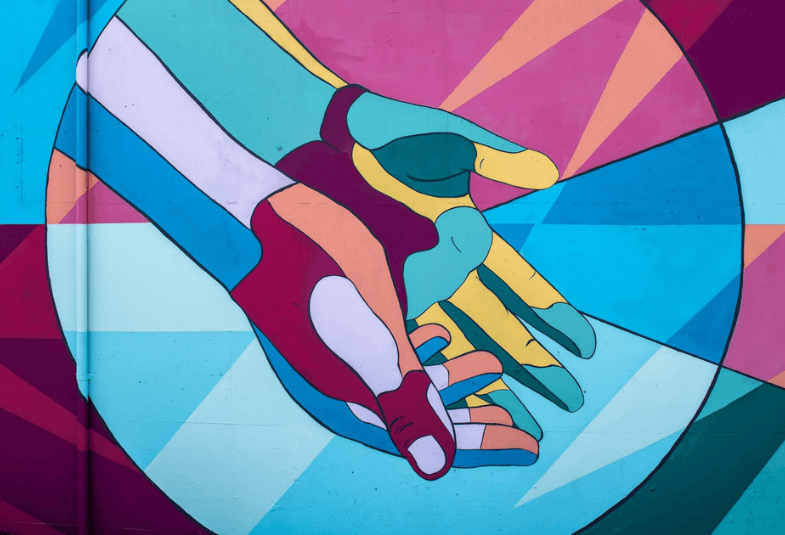If you’ve been to one of my introductory workshops in the last year, you’ve probably heard me say that my identity, especially at work, has been defined by the phrase, “You don’t count.” As a white-assumed Hispanic cisgender woman with an invisible disability, I don’t hold enough power and privilege to participate in the dominant group fully; yet, I hold too much power to be considered part of the collective “non-dominant” group.
The phrase “you don’t count” actually comes from an intersectional exchange with an employee at an organization who, rightfully, believed he had been facing microaggressions and hidden discrimination for being Black. When I tried to talk to him about his experiences at the company to see if I could help, he said, “What’s your right to do DEI anyway? And don’t say because you’re a woman. Because you don’t count…that isn’t enough.”
It was a difficult moment for a number of reasons. For one, as someone who has experienced repeated gender-based violence and workplace sexual harassment, I very much feel my womanhood as a vulnerability and a site of risk. In the exchange, the hijacked part of my brain went to thoughts like, “That’s right, it doesn’t matter if you’re assaulted because you’re a woman. It’s not enough. You’re being hysterical and neurotic.”
It was difficult, too, because it brought me back to the thought that a woman is all I am.
This tendency for members inside of a would-be social identity-based coalition to reproduce “in-groups” and “out-groups” they themselves are categorized in outside of their coalition has been showing up throughout my DEIB practice in the last several months in new ways.
And, the two places that it has most struck have been in broader discussions of “The Great Resignation” and Latinidad.
Unpacking the Worker Shortage

Photo by Kelly Lacy on Pexels
Since early this year, every major news source has been highlighting a seemingly puzzling disconnect between workers and the labor market. Now that more jobs are available than ever, fewer and fewer people are going back to work. Speculation, both research-based and conjecture-rooted, have abounded.
Cal Newport speculated in The New Yorker that the Labor Department’s report of four million workers quitting their jobs in April alone could be connected with knowledge workers waking up to the dissatisfaction of long hours and lots of stuff. While he couldn’t be sure that career downsizing — shifting to a lower pressure, lower-earning mode of work while simultaneously moving to a more affordable region — would become a movement, he was sure of what was causing the experimentation. As he puts it:
“The unceasing presence of video conferencing and e-mail enhanced the Kafkaesque superfluousness of many of the activities that dominated the pre-pandemic workday.”
In the meantime, The New York Times’s The Daily elected to go a different route, interviewing service and essential workers rather than ones entrenched in the knowledge sphere. What the journalist behind the episode found was a group of people who felt especially at risk of contracting the coronavirus, noted unlivable wages and lack of access to childcare, and saw other avenues to economic solvency beyond working extra-long hours for the minimum wage or less (for tip-based workers).
These reasons, among others that have surfaced in the seemingly unending national conversation around the “labor shortage,” ring true while also feeling hollow.
At least in the latter example, The Daily journalists go out of their way to factor in some social identity considerations, such as gender identity and caregiver responsibilities. And, of course, the data support that people from non-dominant groups are returning to work at lower rates. Women are leading the mass exodus for practical reasons tied to lack of work flexibility and increased domestic responsibilities. We also know that white women have more of a choice to leave the workforce, whether totally of their own volition or not, than women of color.
But no data has helped paint a clearer picture of the root cause of “The Great Resignation” for me than that of Project Include’s Remote Work Report. In the report’s survey of three thousand workers, they find evidence that remote work since COVID-19 is exacerbating harm in a number of concrete ways. Specifically:
- 85% percent of respondents reported increased anxiety since the start of COVID-19.
- 98% percent of people who experienced increased gender-based harassment were women and/or nonbinary people.
- 42% of people who identified as transgender reported increase gender-based harassment, compared with 25% of those who identified as cisgender.
- 45% percent of Black women experienced race-based hostility at work.
The report also noted that “Woman and/or Nonbinary people are much more likely to have experienced race-based hostility. Black people are most likely to have experienced increased hostility, regardless of gender.”
In other words, the unceasing video conferencing and email that Cal Newport names as a factor for the mass workplace exodus are a part of this story but not the whole story itself. What is happening in those interactions and to whom might have more to do with the job shortage than we are acknowledging as a society.
It’s worth calling out that the Project Include report is more focused on the workers in Cal Newport’s assessment of the labor market than The Daily’s, namely because service workers are not subject to the same levels of remote versus in-person work. Yet, these service workers are also experienced gender-based harassment and race-based hostility, sometimes in more visceral ways. When employers report that patrons opposed to the vaccine refuse to wear masks in their establishments and spit on the predominantly non-dominant group employees working for them, the social identity component to this phenomenon is undeniable.
Who Counts?

Photo by Tim Mossholder on Unsplash
In the last two years, the rise in union popularity, collective organizing, and employee solidarity have been palpable. Galvanized by pandemic-fueled layoffs and the increases in unprotected gig-based work, workers are withholding their greatest asset, their labor. I have no desire to underscore these accomplishments; instead, I have an observation to share.
In A History of America in Ten Strikes, social historian Erik Loomis writes about the ways in which the labor movement positively shaped our current workplaces, including ending (at least in theory) 72-hour workweeks and instituting real laws around workplace safety. However, he also notes the ways in which bias, prejudice, racism, sexism, and elitism within the labor movement helped undermine some of its most promising potential gains.
What worries me is that in the last six months, I have seen tremendous increases in this same trend within grassroots employee groups. “Who counts?” was a question that started as almost a rallying cry — our employers don’t treat us like we count, and we deserve and demand to be paid a fair wage, given basic job protections, and treated with dignity. But, it’s also become a question of who can participate in the conversation about workplace safety, equity, and justice.
Candidly, one of the places I am noticing it most is in the conversation around Latinx or Hispanic identity. I want to name that I have a heightened awareness of this particular issue because I myself am Hispanic, and my relationship with Latinidad is often questioned because of my fair skin.
Latinx employees, especially ones volunteering with their internal DEI committees, have been reaching out to me and members of my team to ask: “Do we have a right to advocate for ourselves? Are we BIPOC enough? Are we BIPOC at all?” The controversy around Lin-Manuel Miranda’s casting of mostly white-passing or light-skinned Latinx actors for his recent film, In the Heights, wasn’t lost on these same employees. An email I received from a Bolivian-American employee at a tech startup early in August contained this phrase: “In the U.S., if I’m not Afro-Latina, am I Latina at all?”
I share these examples not to in any way diminish the Afro-Latinx experience; in fact, we know from the data (reported earlier in this article) that Afro-Latinx people are more likely to experience harassment and hostility. The calls to increase Afro-Latinx representation in media, in companies, and in public life are valid, necessary, and vital.
However, what sticks with me is the increasing tension along the spectrums of Latinidad, of color, of non-dominant status.
In my own experience, it’s not people from within the Latinx community who are calling out my “insufficiency” or “not-enoughness” as a white-assumed Hispanic person — it’s members of other nondominant groups, and that is socially isolating.
In a current world where we feel more alienated from our companies, our leaders, and even our peers in challenging remote and in-person environments, the lack of support from within our own communities is especially demoralizing.
I believe we can advocate for those most impacted by our unequal and inequitable power structures without having to deny our own identities or remove ourselves from the movement. As Audre Lorde famously said, “The master’s tools will never dismantle the master’s house.” A scarcity mindset, identity-based competition, and extreme individualism at the expense of solidarity are all tools that maintain the current system. To change the system for good, we have to find another way.
In an interview with Columbia Law School, civil rights activist Kimberlé Crenshaw brilliantly puts the conversation around identity into another kind of focus.
“Intersectionality is a lens through which you can see where power comes and collides, where it interlocks and intersects. It’s not simply that there’s a race problem here, a gender problem here, and a class or LBGTQ problem there.”
We have to pay attention to the people who are subject to all of those power collisions, those most impacted, while recognizing that we do not exist as separate entities from this interlocking system. Saying that it is not enough to only foreground white-identifying or white-passing Latinx actors, for example, is not the same as saying those people do not belong to their group or experience their own discriminations.

